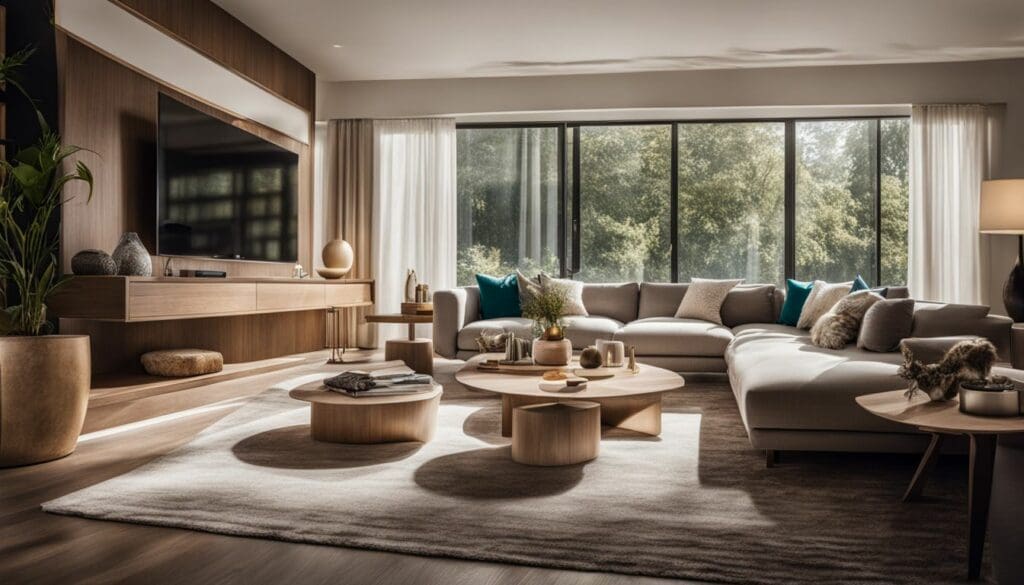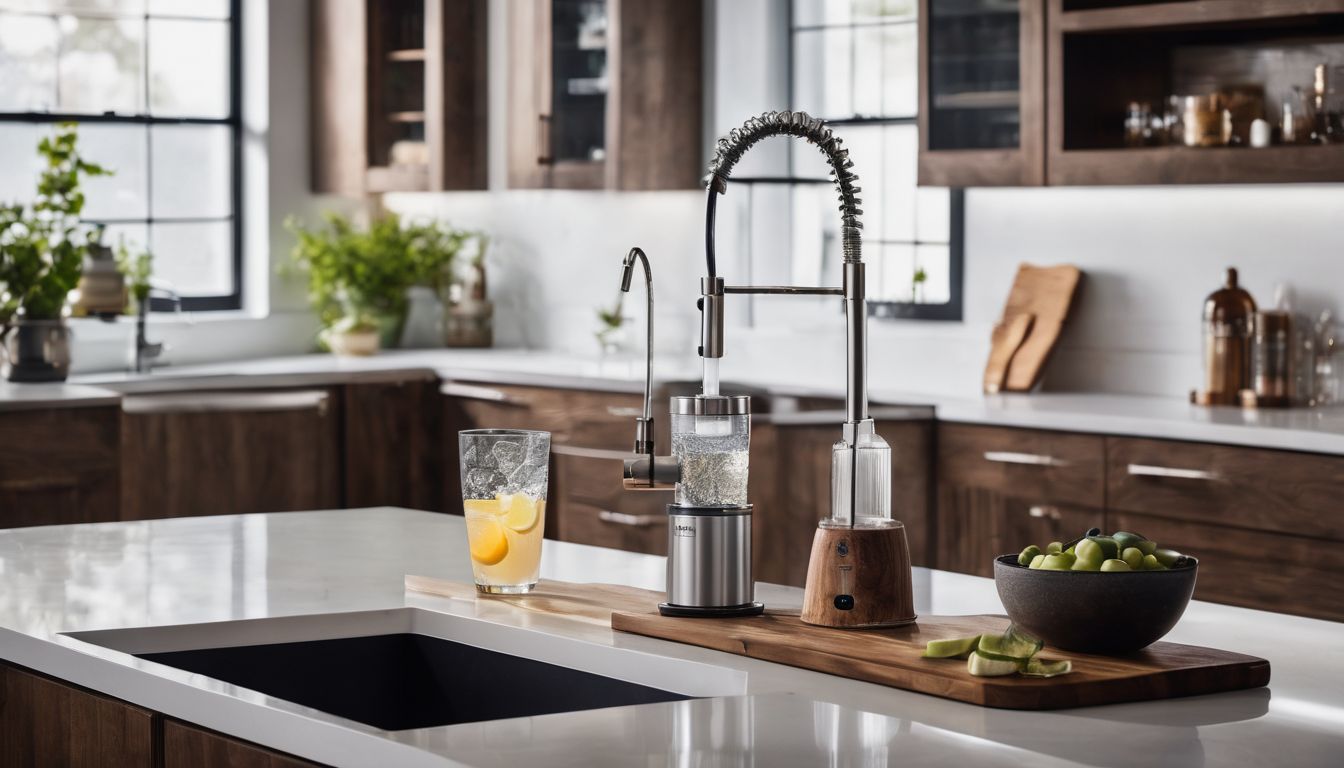Struggling with dim rooms can make your home feel dreary. Sunlight shapes our days and lifts our mood, without us even noticing. This post will beam through the gloom, showcasing how natural light can transform your living space.
Let’s brighten up!
Key Takeaways
- Sunlight boosts mood by helping to regulate hormones and reduce stress levels, while also saving on energy costs through less reliance on artificial lighting.
- Natural light can increase a home’s value due to its appeal; bright spaces are more attractive and can make properties more desirable to potential buyers.
- Exposure to natural light is essential for producing Vitamin D in the skin, which strengthens bones and the immune system, while also benefiting vision and promoting healthy plant growth indoors.
- Introducing mirrors, using reflective surfaces, and having light – coloured walls are effective strategies for maximising natural light within your home environment.
- Designing with plenty of windows or adding skylights ensures that you get enough sunlight throughout your living space, enhancing well-being and reducing dependence on electric lights.
The Importance of Natural Lighting in Home Design
Natural lighting plays a crucial role in home design, impacting the mood, energy, and materials used within a space. It can create a sense of spaciousness and airiness while reducing the need for artificial lighting.
How natural light impacts mood, materials, and energy in a space
Sunlight streaming through windows not only brightens a room but lifts spirits as well. Exposure to natural light during the day helps regulate hormones, keeping mood swings at bay and fostering a sense of wellbeing.
This psychological uplift translates into enhanced focus and lower levels of stress, positively influencing daily life within homes or workplaces.
Materials in your space also respond to the touch of daylight; it can reveal true colours and textures that artificial lighting can mask. Energy-wise, embracing sunlight reduces reliance on electrical lighting, saving money while supporting conservation efforts.
By designing spaces with ample windows or skylights, solar energy naturally warms rooms, potentially decreasing heating requirements in colder months.
Benefits of Natural Lighting in the Home
Natural lighting in the home saves energy and money, increases focus and productivity, reduces stress and anxiety, boosts the immune system, improves happiness and prevents SAD, provides essential Vitamin D, benefits vision and plant growth, aids in weight loss and mental sharpness, increases energy and improves sleep.
To learn more about how natural light can benefit your home design, keep reading!
Saves energy and money
Maximising natural light in your home can significantly reduce your energy consumption, cutting down on electricity costs and decreasing your carbon footprint. By allowing sunlight to illuminate your living space, you rely less on artificial lighting and heating, leading to substantial savings over time.
Properly harnessing natural light also means relying less on air conditioning during the warmer months. With strategic window placement and thoughtful design choices, you can keep indoor temperatures comfortable without constantly running cooling systems, ultimately lowering your energy bills while benefiting the environment.
Increases focus and productivity
Natural light in home design leads to increased focus and productivity, with its ability to create a more vibrant and stimulating environment. The natural illumination elevates the mood, enhances mental sharpness, and energises individuals.
This fosters a productive atmosphere for work or study, promoting efficiency and concentration within the space.
The positive effects of natural light contribute to heightened alertness and improved performance in tasks. By optimising natural lighting through strategic window placement and reflective surfaces, homeowners can harness these benefits for enhanced focus and productivity.
Reduces stress and anxiety
Increases focus and productivity can lead to stress and anxiety, but natural light can help counter these negative effects. Exposure to natural light has been shown to lower cortisol levels, which are associated with stress.
The calming effect of sunlight on the brain promotes relaxation and reduces feelings of tension. Sunlight also triggers the release of serotonin, a neurotransmitter that contributes to feelings of wellbeing and happiness.
The psychological benefits of natural light in reducing stress and anxiety make it an essential element in home design. Strategically incorporating ample daylight into living spaces can create a soothing atmosphere, promoting mental wellness for both individuals and families living in the home.
Boosts immune system
Natural light boosts the immune system by stimulating the production of white blood cells, which are essential for fighting off infections and illnesses. This is due to the exposure to UV rays that trigger Vitamin D synthesis in the skin, supporting a healthier immune response.
Additionally, natural light can help regulate circadian rhythms, promoting better sleep patterns and overall well-being.
Exposure to natural light has been linked to increased levels of serotonin, which can enhance mood and strengthen the body’s defenses against common ailments. It also supports mental health and reduces stress through its positive impact on emotional stability.
Increases home value
Maximizing natural light in your home can have a direct impact on increasing its overall value. Sunlight-filled spaces are attractive to potential buyers and can significantly enhance the appeal of your property.
Bright, naturally lit homes are sought after for their inviting atmosphere and aesthetic appeal, leading to increased demand and potentially higher resale values.
Strategic use of natural lighting not only creates an appealing ambiance but also showcases architectural features, making the space feel larger and more open. This emphasis on brightness and spaciousness is highly desirable to environmentally conscious individuals seeking sustainable living spaces that prioritise energy-efficient design.
Improves happiness and prevents SAD
Natural light has a direct impact on our emotional well-being. It promotes the production of serotonin, the feel-good hormone, and reduces the risk of seasonal affective disorder (SAD) by mimicking sunlight’s mood-boosting effects.
Exposure to natural light can uplift moods, increase feelings of happiness, and prevent SAD especially during long winter months. Additionally, it fosters a positive environment that enhances overall well-being and mental health.
Considering these benefits in your home design not only creates a healthier living space but also supports environmental sustainability by reducing reliance on artificial lighting.
Provides essential Vitamin D
Natural light is a vital source of vitamin D, which helps regulate calcium and phosphorus absorption, supporting healthy bones and teeth. Exposure to sunlight stimulates the skin’s production of vitamin D, an important nutrient for overall well-being.
By incorporating natural light into your home design, you facilitate the body’s natural production of this essential vitamin, promoting good health.
Letting natural light into your living space can help maintain adequate levels of vitamin D in a way that artificial lighting simply cannot replicate. Proper exposure to sunlight through well-placed windows or skylights ensures that you receive this vital nutrient while enhancing the ambiance and aesthetic appeal of your home.
Benefits vision and plant growth
Natural light is essential for healthy vision and plant growth. Sunlight provides a full spectrum of light, which is crucial for colour perception and maintaining optimal eye health.
Additionally, natural light stimulates photosynthesis in plants, promoting their growth and development. When designing your home with natural lighting in mind, consider the benefits to both human health and greenery within your living space.
To maximise these benefits, it’s important to strategically place windows and incorporate skylights where possible. This will not only enhance the visual appeal of your home but also contribute to a healthier environment indoors.
Furthermore, positioning houseplants near sources of natural light can improve air quality while brightening up your living space.
Can aid in weight loss and mental sharpness
Natural light exposure has been linked to better weight management and mental acuity. Studies suggest that people exposed to natural light daily tend to have improved metabolism and are more mentally alert throughout the day.
The body’s circadian rhythm is regulated by natural light, which in turn affects appetite and energy levels, contributing positively towards maintaining a healthy weight. Furthermore, exposure to natural light has been associated with enhanced cognitive function, including better memory, focus, and overall mental sharpness.
Experiencing ample natural light at home through strategic design choices can support these benefits for individuals striving for optimal health and productivity.
Increases energy and improves sleep
Harnessing natural light in your home can also lead to an increase in energy and improved sleep patterns. The exposure to natural light during the day helps regulate your body’s internal clock, promoting better sleep at night.
Furthermore, the influx of daylight provides a much-needed boost of energy and alertness, contributing to improved productivity throughout the day.
How to Maximise Natural Lighting in Your Home
Maximise natural lighting in your home by strategically placing windows and using reflective surfaces to bounce light around the room. Keep curtains and blinds open during the day, or consider adding skylights for even more sunlight.
Use appropriate window placement and size
Position windows strategically to allow natural light to penetrate deep into the room, ensuring they are large enough for ample sunlight. Place windows on multiple walls to maximise the entry of natural light from different angles, providing a well-lit environment throughout the day.
Opt for larger windows in living spaces and smaller ones in private areas such as bathrooms.
Ensure that each window is properly sized according to the space it illuminates, letting in adequate sunlight without overwhelming the room. Windows should be proportionate to the wall size and placed higher up near the ceiling if possible, enabling more light diffusion and creating an open and airy ambiance Keywords: window placement, appropriate size, natural light penetration, strategic positioning, adequate sunlight.
Choose light-coloured walls and reflective surfaces
To further enhance natural lighting in your home, consider choosing light-coloured walls and reflective surfaces. Light shades such as whites, creams, and pastels help to bounce natural light around the room, creating a brighter and more welcoming atmosphere.
Reflective surfaces like mirrors or glossy furniture can also amplify the effects of natural light by dispersing it throughout the space.
By selecting these design elements, you can optimise the available natural light in your home without relying heavily on artificial sources. This not only contributes to energy efficiency but also promotes a healthier and more vibrant living environment for you and your family.
Optimise natural light with mirrors and furniture placement
Place mirrors strategically in your home to reflect natural light and brighten up dark corners. Position them opposite windows to maximise the distribution of sunlight throughout the space.
Additionally, consider choosing furniture with reflective surfaces such as glass or metal to bounce light around the room, creating a more luminous atmosphere that reduces the need for artificial lighting.
Strategic placement of mirrors and furniture can optimise natural light in your home, enhancing its eco-friendly design while providing an uplifting and energy-efficient living environment.
Keep curtains and blinds open during the day
Allow natural light to flood your home by keeping curtains and blinds open during the day. This simple practice maximises the benefits of natural lighting, creating a bright and welcoming atmosphere while reducing the need for artificial lighting.
By doing so, you can save on energy costs and decrease your environmental footprint, all while enjoying the mood-enhancing effects of sunlight.
Welcome an invigorating ambiance into your living space with this effortless step that promotes sustainability. Embrace the positivity and warmth that natural light brings into your home – both for yourself and the environment.
Consider skylights or light tubes
To further maximise natural light in your home, consider the installation of skylights or light tubes. These fixtures can bring in additional sunlight from above, brightening up dark spaces and reducing the need for artificial lighting.
Skylights and light tubes are excellent options for increasing the amount of natural light in areas where traditional windows may not be feasible, such as bathrooms, corridors, or rooms with limited wall space.
By incorporating these features into your home design, you can enjoy the benefits of natural light throughout more areas of your living space while reducing energy consumption.
Skylights and light tubes not only enhance interior aesthetics but also contribute to energy efficiency by providing an additional source of illumination during daylight hours. With this eco-friendly approach to lighting design, you can reduce reliance on electric lighting and lower overall energy consumption.
Related Posts and Inspiration for Natural Light in Home Design
Discover the calming and serene effect of natural light in a dreamy white bedroom, or explore how to curate a collection that maximises the use of sunlight in your home. Understand the impact of interior design on our lifestyle and learn about potential pitfalls related to gender differences in design choices.
Dreamy white bedroom
The dreamy white bedroom is an ideal space for maximising natural light. The use of light-coloured walls and reflective surfaces helps to enhance the brightness, creating a fresh and airy atmosphere.
Choosing sheer curtains or keeping them open during the day allows maximum sunlight to enter the room, while strategically placing mirrors can amplify the natural light further. This design not only creates an inviting space but also aligns with environmentally conscious individuals’ appreciation for energy-efficient home practices.
In addition to being visually appealing, a dreamy white bedroom with ample natural light provides numerous health benefits such as mood enhancement, reduction of stress and anxiety, and improved sleep quality.
Curating a collection in your home
Selecting and arranging a collection of items in your home can be a creative way to showcase your personality and style. Utilising natural light when curating your collection can enhance the visual appeal of the objects, creating a warm and welcoming atmosphere.
By strategically placing items near windows or under skylights, you can take advantage of the sunlight to highlight textures, colours, and details within your collection. This not only adds depth and interest to your space but also contributes to reducing energy consumption by relying on natural lighting during the day.
When you curate a collection in your home using natural light, it allows for better appreciation of each piece while minimising the need for artificial lighting. Consider incorporating eco-friendly materials into your curated space, as they align with an environmentally conscious lifestyle and further contribute to sustainable living practices.
Pitfalls of design and gender differences
When designing spaces, it’s important to consider potential gender differences in preferences and needs. Selecting furniture, lighting, and colours should be mindful of diverse tastes and spatial requirements.
Gender-neutral design can create inclusive environments that cater to all occupants equally. It’s crucial to avoid stereotypical assumptions about design choices based on gender, as this can lead to exclusionary spaces.
To prevent pitfalls related to gender differences in design, architects should aim for versatility in layout and functionality. Integrating adaptable elements allows for personalised adjustments while avoiding imposing fixed ideas about how a space should be used or accessed by different genders.
How interior design impacts our lifestyle
As we consider the impact of interior design on our lifestyle, it’s important to recognise how natural light plays a pivotal role in shaping our daily experiences. The use of natural lighting influences mood regulation, energy levels and overall well-being.
When harnessed effectively, natural light can significantly contribute to a healthier and more sustainable way of living.
The incorporation of ample natural lighting within interior spaces directly affects our physical health and emotional wellness. It creates an inviting environment that fosters productivity, reduces stress and enhances overall happiness by connecting us with nature through sustainable design elements.
Conclusion
In conclusion, natural light in home design has numerous benefits for both our physical and mental well-being. Maximising natural lighting can help save energy and money while also improving focus, productivity, and overall happiness.
It’s essential to consider the impact of natural light when designing living spaces to create a healthy and vibrant environment. By incorporating strategies to maximise natural light, we can enhance our homes and positively impact our lives.
FAQs
1. Why is natural light important in home design?
Natural light plays a crucial role in interior design, boosting energy savings, enhancing mood, and providing health benefits from the sun’s UV rays.
2. How does natural lighting benefit our health?
The benefits of natural light on health include reducing stress, improving sleep quality, and offering positive effects like increased vitamin D levels from sunlight exposure.
3. Can increasing natural sunlight at home also improve productivity?
Yes! Incorporating more sunbeams into your home can lead to greater productivity and a better sense of well-being.
4. Are there disadvantages to using too much natural light in the home?
While there are many advantages, excessive natural light without proper control can lead to glare and higher indoor temperatures which might require solutions like shading or UV protection for comfort.
5. What are some ways I can bring more natural light into my house?
You can increase the amount of sunshine in your living space by adding mirrors to reflect light, installing larger windows, or using skylights to illuminate dark areas with daylight.





